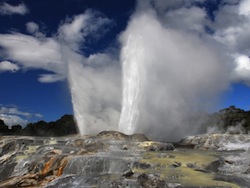According to the latest issue of the U.S. Energy Information Administration’s (EIA) “Electric Power Monthly,” renewable energy sources (biomass, geothermal, solar, wind) increased by 12.8 percent last year compared to 2011 and provided 5.4 percent of net U.S. electrical generation. Solar increased by 138.9 percent while wind grew 16.6 pecent, geothermal by 9.6 percent, and biomass (i.e., wood, wood-derived fuels, and other biomass) by 1.6 percent. Since 2007, non-hydro renewables have more than doubled their contribution to the nation’s electrical supply.
 At the same time (2012 compared to 2011), total net U.S. electrical generation dropped by 1.1 percent with petroleum coke & liquids down by 24.1 percent, coal by 12.5 percent, and nuclear by 2.6 percent. Less than a decade ago, coal provided more than half the nation’s electricity, fell to 37.4 percent while nuclear fell below 19 percent. Conventional hydropower also declined by 13.4 percent due to last year’s drought and lower water flows, but natural gas expanded by 21.4 percent to provide 30.3 percent of net electrical generation.
At the same time (2012 compared to 2011), total net U.S. electrical generation dropped by 1.1 percent with petroleum coke & liquids down by 24.1 percent, coal by 12.5 percent, and nuclear by 2.6 percent. Less than a decade ago, coal provided more than half the nation’s electricity, fell to 37.4 percent while nuclear fell below 19 percent. Conventional hydropower also declined by 13.4 percent due to last year’s drought and lower water flows, but natural gas expanded by 21.4 percent to provide 30.3 percent of net electrical generation.
Conventional hydropower and non-hydro renewable sources combined accounted for 12.22 percent of net U.S. electrical generation. However, as EIA has noted in the past, these figures do not comprehensively reflect distributed, non-grid connected generation and thereby understate the full contribution of renewables to the nation’s electrical supply.
EIA’s report also reveals the top renewable-electricity generating states for 2012: top five wind states: Texas, Iowa, California, Oklahoma, and Illinois; top five biomass states: California, Florida, Maine, Georgia, and Alabama; top five geothermal States: California, Nevada, Utah, Hawaii and Idaho; and top five solar states: California, Arizona, Nevada, New Jersey, and New Mexico.
“Technical advances, falling costs, and the desire to address climate change have combined to rapidly expand the contribution of renewable energy to the nation’s electrical generation,” said Ken Bossong, Executive Director of the SUN DAY Campaign. “With the right policy incentives, one can foresee these cleaner energy sources providing the bulk of the nation’s electrical needs within a generation.”

